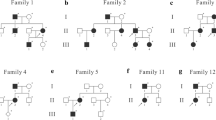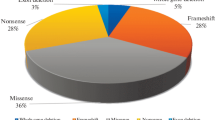Abstract
Neurofibromatosis type 1 (NF1) is caused by mutations in the NF1 gene. This retrospective study aims to evaluate the clinical manifestations and brain magnetic resonance images (MRI) analysis in 60 genetically confirmed NF1 patients. The results of next-generation sequencing (NGS), Sanger sequencing, and MLPA of NF1 gene were evaluated. A total of 54 different variants were identified. Fourteen out of them were novel variants (25.9%). Patients who complied with NIH criteria had most frequently frameshift variants (11/32 patients), and those with only CALMs had missense variants (9/28 patients). Neurofibromatosis type 1 bright objects (NBOs) on T2-weighted MRI were detected in 42 patients (42/56; 75%). These brain lesions were detected mostly in basal ganglia and in cerebellar vermis. NBOs were detected more in the patients who complied with NIH criteria (80.6%) compared to those who were only CALMs (68%). While frameshift variants (33.3%) were the most common type variants in the patients who had NBOs, the most common variants were splicing (35.7%) and missense (35.7%) variants in the patients whose MRIs were normal. Frameshift variants (11/28 patients; 39.3%) were the most common in the patients with more than one brain locus involvement. Therefore, we consider that frameshift variants may be associated with increased incidence of NBOs and involvement of more than one brain locus. In addition, NBOs may occur less frequently in the patients with splicing variants. To our knowledge, this is the first study evaluated the relationship between NF1 gene variants and NBOs. Future studies may help us understand the etiology of NBOs.


Similar content being viewed by others

References
Hirbe AC, Gutmann DH (2014) Neurofibromatosis type 1: a multidisciplinary approach to care. Lancet Neurol 13:834–843
National Institutes of Health Consensus Development Conference Statement on Acoustic Neuroma (1991) The consensus development panel (1994). Arch Neurol 51:201–207
Ferrari F, Masurel A, Olivier-Faivre L, Vabres P (2014) Juvenile xanthogranuloma and nevus anemicus in the diagnosis of neurofibromatosis type 1. JAMA Dermatol 150:42–46
Tekin M, Bodurtha JN, Riccardi VM (2001) Cafe au lait spots: the pediatrician’s perspective. Pediatr Rev 22:82–90
Nunley KS, Gao F, Albers AC et al (2009) Predictive value of café au lait macules at initial consultation in the diagnosis of neurofibromatosis type 1. Arch Dermatol 145:883–887
Bayat M, Bayat A (2020) Neurological manifestations of neurofibromatosis: a review. Neurol Sci 41:2685–2690
Baudou E, Nemmi F, Biotteau M, Maziero S, Peran P, Chaix Y (2020) Can the cognitive phenotype in neurofibromatosis type 1 (NF1) be explained by neuroimaging? A review. Front Neurol 10:1373
Lopes Ferraz Filho JR, Munis MP, Soares Souza A et al (2008) Unidentified bright objects on brain MRI in children as a diagnostic criterion for neurofibromatosis type 1. Pediatr Radiol 38:305–310
Wallace MR, Marchuk DA, Andersen LB et al (1990) Type 1 neurofibromatosis gene: identification of a large transcript disrupted in three NF1 patients. Science 249:181–186
Cawthon RM, Weiss R, Xu GF et al (1990) A majör segment of the neurofibromatosis type 1 gene: cDNA sequence, genomic structure, and point mutations. Cell 62:193–201
Martin GA, Viskochil D, Bollag G et al (1990) The GAP-related domain of the neurofibromatosis type 1 gene product interacts with ras p21. Cell 63:843–849
Xu GF, O'Connell P, Viskochil D et al (1990) The neurofibromatosis type 1 gene encodes a protein related to GAP. Cell 62:599–608
Bollag G, McCormick F (1991) Differential regulation of ras GAP and neurofibromatosis gene product activities. Nature 351:576–579
Marchuk DA, Saulino AM, Tavakkol R et al (1991) cDNA cloning of the type 1 neurofibromatosis gene: complete sequence of the NF1 gene product. Genomics 11:931–940
Yu H, Zhao X, Su B, Li D, Xu Y, Luo S, Xiao C, Wang W (2005) Expression of NF1 pseudogenes. Hum Mutat 26:487–488
Castle B, Baser ME, Huson SM, Cooper DN, Upadhyaya M (2003) Evaluation of genotype-phenotype correlations in neurofibromatosis type 1. J Med Genet 40:e109
Ulusal SD, Gürkan H, Atlı E et al (2017) Genetic analyses of the NF1 gene in Turkish neurofibromatosis type I patients and definition of three novel variants. Balkan J Med Genet 20:13–20
Pasmant E, de Saint-Trivier A, Laurendeau I, Dieux-Coeslier A, Parfait B, Vidaud M, Vidaud D, Bièche I (2008) Characterization of a 7.6-Mb germline deletion encompassing the NF1 locus and about a hundred genes in an NF1 contiguous gene syndrome patient. Eur J Hum Genet 16:1459–1466
Zhu L, Zhang Y, Tong H, Shao M, Gu Y, du X, Wang P, Shi L, Zhang L, Bi M, Wang X, Zhang G (2016) Clinical and molecular characterization of NF1 patients: single-center experience of 32 patients from China. Medicine (Baltimore) 95:e3043
Richards S, Aziz N, Bale S, ACMG Laboratory Quality Assurance Committee et al (2015) ACMG laboratory quality assurance committee. Standards and guidelines for the interpretation of sequence variants: a joint consensus recommendation of the American College of Medical Genetics and Genomics and the Association for Molecular Pathology. Genet Med 17:405–424
Adzhubei I, Jordan DM, Sunyaev SR (2013) Predicting functional effect of human missense mutations using PolyPhen-2. Curr Protoc Hum Genet 76(Chapter 7):Unit7.20
Kumar P, Henikoff S, Ng PC (2009) Predicting the effects of coding non-synonymous variants on protein function using the SIFT algorithm. Nat Protoc 4:1073–1081
Schwarz JM, Cooper DN, Schuelke M et al (2014) MutationTaster2: mutation prediction for the deep-sequencing age. Nat Methods 11:361–362
Upadhyaya M (2010) Neurofibromatosis type 1: diagnosis and recent advances. Expert Opin Med Diagn 4:307–322
Jett K, Friedman JM (2010) Clinical and genetic aspects of neurofibromatosis 1. Genet Med 12:1–11
Bianchessi D, Morosini S, Saletti V, Ibba MC, Natacci F, Esposito S, Cesaretti C, Riva D, Finocchiaro G, Eoli M (2015) 126 novel mutations in Italian patients with neurofibromatosis type 1. Mol Genet Genomic Med 3:513–525
Palma Milla C, Lezana Rosales JM, López Montiel J et al (2018) Neurofibromatosis type I: mutation spectrum of NF1 in spanish patients. Ann Hum Genet 82:425–436
Barrea C, Vaessen S, Bulk S et al (2018) Phenotype-genotype correlation in children with neurofibromatosis type 1. Neuropediatrics 49:180–184
Alwan S, Tredwell SJ, Friedman JM (2005) Is osseous dysplasia a primary feature of neurofibromatosis 1 (NF1)? Clin Genet 67:378–390
Van Minkelen R, van Bever Y, Kromosoeto JN et al (2014) A clinical and genetic overview of 18 years neurofibromatosis type 1 molecular diagnostics in the Netherlands. Clin Genet 85:318–327
Tsipi M, Poulou M, Fylaktou I, Kosma K, Tsoutsou E, Pons MR, Kokkinou E, Kitsiou-Tzeli S, Fryssira H, Tzetis M (2018) Phenotypic expression of a spectrum of neurofibromatosis type 1 (NF1) mutations identified through NGS and MLPA. J Neurol Sci 395:95–105
Giugliano T, Santoro C, Torella A et al (2019) Clinical and genetic findings in children with neurofibromatosis type 1, Legius syndrome, and other related neurocutaneous disorders. Genes (Basel) 10:580
Messiaen LM, Callens T, Mortier G et al (2000) Exhaustive mutation analysis of the NF1 gene allows identification of 95% of mutations and reveals a high frequency of unusual splicing defects. Hum Mutat 15:541–555
Zatkova A, Messiaen L, Vandenbroucke I, Wieser R, Fonatsch C, Krainer AR, Wimmer K (2004) Disruption of exonic splicing enhancer elements is the principal cause of exon skipping associated with seven nonsense or missense alleles of NF1. Hum.Mutat 24:491–501
Mattocks C, Baralle D, Tarpey P, ffrench-Constant C, Bobrow M, Whittaker J (2004) Automated comparative sequence analysis identifies mutations in 89% of NF1 patients and confirms a mutation cluster in exons 11–17 distinct from the GAP related domain. J Med Genet 41:e48
Zhang J, Tong H, Fu X et al (2015) Molecular characterization of NF1 and neurofibromatosis type 1 genotype-phenotype correlations in a Chinese population. Sci Rep 5:11291
Ars E, Kruyer H, Morell M, Pros E, Serra E, Ravella A, Estivill X, Lázaro C (2003) Recurrent mutations in the NF1 gene are common among neurofibromatosis type 1 patients. J Med Genet 40:e82
Pasmant E, Vidaud M, Vidaud D, Wolkenstein P (2012) Neurofibromatosis type 1: from genotype to phenotype. J Med Genet 49:483–489
De Raedt T, Brems H, Wolkenstein P et al (2003) Elevated risk for MPNST in NF1 microdeletion patients. Am J Hum Genet 72:288–1292
Kluwe L, Siebert R, Gesk S, Friedrich RE, Tinschert S, Kehrer-Sawatzki H, Mautner VF (2004) Screening 500 unselected neurofibromatosis 1 patients for deletions of the NF1 gene. Hum Mutat 23:111–116
Pasmant E, Sabbagh A, Spurlock G, Laurendeau I, Grillo E, Hamel MJ, Martin L, Barbarot S, Leheup B, Rodriguez D, Lacombe D, Dollfus H, Pasquier L, Isidor B, Ferkal S, Soulier J, Sanson M, Dieux-Coeslier A, Bièche I, Parfait B, Vidaud M, Wolkenstein P, Upadhyaya M, Vidaud D, members of the NF France Network (2010) NF1 microdeletions in neurofibromatosis type 1: from genotype to phenotype. Hum Mutat 31:E1506–E1518
Ning X, Farschtschi S, Jones A, Kehrer-Sawatzki H, Mautner VF, Friedman JM (2016) Growth in neurofibromatosis 1 microdeletion patients. Clin Genet 89:351–354
Kehrer-Sawatzki H, Mautner VF, Cooper DN (2017) Emerging genotype-phenotype relationships in patients with large NF1 deletions. Hum Genet 136:349–376
Friedman JM. Neurofibromatosis 1. In: Adam MP, Ardinger HH, Pagon RA et al (eds) GeneReviews. University of Washington, pp 1993–2020
Prada CE, Hufnagel RB, Hummel TR et al (2015) The use of magnetic resonance imaging screening for optic pathway gliomas in children with neurofibromatosis type 1. J Pediatr 167:851–856
Sellmer L, Farschtschi S, Marangoni M, Heran MKS, Birch P, Wenzel R, Mautner VF, Friedman JM (2018) Serial MRIs provide novel insight into natural history of optic pathway gliomas in patients with neurofibromatosis 1. Orphanet J Rare Dis 13:62
Blanchard G, Lafforgue MP, Lion-François L et al (2016) Systematic MRI in NF1 children under six years of age for the diagnosis of optic pathway gliomas. Study and outcome of a French cohort. Eur J Paediatr Neurol 20:275–281
DeBella K, Poskitt K, Szudek J, Friedman JM (2000) Use of “unidentified bright objects” on MRI for diagnosis of neurofibromatosis 1 in children. Neurology 54:1646–1650
Mentzel HJ, Seidel J, Fitzek C et al (2005) Pediatric brain MRI in neurofibromatosis type I. Eur Radiol 15:814–822
Author information
Authors and Affiliations
Corresponding author
Ethics declarations
Conflict of interest
The authors declare that they have no conflict of interest.
Ethical approval
None
Financial Disclosure
The authors have no financial relationships relevant to this article to disclose.
Additional information
Publisher’s note
Springer Nature remains neutral with regard to jurisdictional claims in published maps and institutional affiliations.
Rights and permissions
About this article
Cite this article
Hazan, F., Gürsoy, S., Unalp, A. et al. Evaluation of clinical findings and neurofibromatosis type 1 bright objects on brain magnetic resonance images of 60 Turkish patients with NF1 gene variants. Neurol Sci 42, 2045–2057 (2021). https://doi.org/10.1007/s10072-020-04988-0
Received:
Accepted:
Published:
Issue Date:
DOI: https://doi.org/10.1007/s10072-020-04988-0



